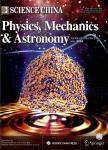Magnetism induced by nonmagnetic dopants in zinc-blende SiC: First-principle calculations
Magnetism induced by nonmagnetic dopants in zinc-blende SiC: First-principle calculations作者机构:Tsinghua University Department of Physics and Key Laboratory of Atomic and Molecular Nanoscience (Ministry of Education) Beijing China (GRID:grid.12527.33) (ISNI:***)
出 版 物:《Science China(Physics,Mechanics & Astronomy)》 (中国科学:物理学、力学、天文学(英文版))
年 卷 期:2010年第53卷第1期
页 面:1-10页
核心收录:
学科分类:07[理学] 0809[工学-电子科学与技术(可授工学、理学学位)] 070205[理学-凝聚态物理] 08[工学] 0805[工学-材料科学与工程(可授工学、理学学位)] 080502[工学-材料学] 0704[理学-天文学] 0702[理学-物理学]
基 金:Supported by the National Natural Science Foundation of China (Grant Nos.10674076 and 10721404) the Major Project of National Basic Research Program of China (Grant No. 2006CB605105)
主 题:nonmagnetic dopant magnetism SiC diluted magnetic semiconductor first-principle calculation
摘 要:Magnetism induced by the nonmagnetic dopants in the zinc-blende SiC (3C-SiC) is investigated by first-principle calculations. The atoms of the first 20 elements in the periodic table except inert gas are used to replace either Si or C atoms as dopants. We find that some nonmagnetic substitutional dopants (mainly the Group IA, Group IIA, Group IIIB, and Group VIIB elements) prefer the spin-polarized ground states with local magnetic moments. In general, the condition for obtaining the local magnetic moments and the magnetic ground state requires that the dopants are p-type and have large electronegativity difference from the neighboring host atoms. The magnetic moments can be tuned over a range between 1 μ B and 3 μ B by doping with the nonmagnetic elements. The nearest-neighbor exchange couplings J 0 between the local magnetic moments are quite large and the codoping method is proposed to increase the dopant concentration. These imply that the nonmagnetic doping in SiC may exhibit collective magnetism. Moreover, the Group IIA Mg and Ca atoms substituting the preferred Si atoms favor the ferromagnetic ground states with the half-metallic electronic properties, which suggests that Mg or Ca substitutional doping on the Si sites in SiC could be a potential route to fabricating the diluted magnetic semiconductors.



